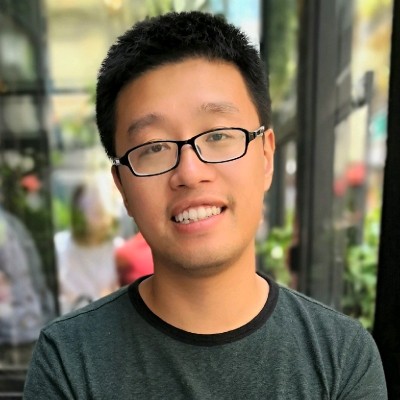
Guanyi Huang, associate principal scientist at Merck, has often found himself in the right place at the right time.
The son of a middle school math teacher and computer science professor-turned-entrepreneur, Huang developed an early fascination with molecular biology. He grew up in the city of Xinyang in central China, and majored in biology as an undergraduate and master’s student at the University of Science and Technology of China in Hefei.
In 2009, he moved to California and started his PhD studies in genetics, molecular and cell biology in the Programs in Biological and Biomedical Sciences (PIBBS) at the Keck School of Medicine of USC. After completing his required three lab rotations, he opted to spend a summer doing an extra fourth rotation in the USC Stem Cell lab of Qi-Long Ying and discovered a new passion.
“Stem cell research is really interesting,” he said. “It’s very basic cell biology and molecular biology. But at the same time, you could almost see the future of clinical use—and use them to solve both basic biological questions, and also for therapeutic purposes. So this is really at the forefront, and would be very valuable knowledge to apply to other aspects of biology.”
Huang joined the Ying Lab, with support from a California Institute for Regenerative Medicine (CIRM) Scholars training grant—a decisive step setting him on the path to a career advancing stem cell therapies in California’s booming biotech sector.
“The CIRM training grant really is wonderful for first-year and second-year PhD students, because I didn’t have to work as a teaching assistant and could focus a hundred percent in the lab to really get myself ready as an independent researcher,” he said. “There were also a lot of opportunities to share your posters and your findings and experiments with other folks, and to communicate them [at conferences and] just basically get in touch with the core stem cell community. As a young PhD student at that time, it was really helpful.”
For Huang, joining the Ying Lab was a case of being in the right place at the right time. He not only learned about the molecular underpinnings that drive embryonic stem cells to self-renew and make more copies of themselves, but also developed valuable expertise in genome editing at an ideal moment.
“Those were the early days when genome editing first became a thing,” he said. “There were different generations of genome editing platforms, from the original zinc fingers to TALENs. Then eventually, when I graduated, CRISPR first came out. I was really there during a fortunate time where you had a real explosion and rapid progress in this field. It wasn’t really a field when I joined the lab, and by the time I graduated, everyone was working on it. The Nobel Prize was awarded then, too. So I was very lucky to be studying these technologies, which became very valuable for my career progress, and to be using these wonderful tools for understanding biology.”
Huang credits the CIRM Scholars program with giving him the time, mentorship, and community he needed to grow as a researcher, and ultimately set him on the path to working in California’s biotech industry. The combination of protected lab time, specialized training, and early networking opportunities provided the foundation to become a leader in regenerative medicine.
After graduating with his PhD in 2014, Huang made plans to pursue his postdoctoral training in the lab of Joseph C. Wu at Stanford University—and once again found himself in the right place at the right time.
Wu was about to launch a startup company called Stem Cell Theranostics to develop genetically-targeted therapies for heart failure. So instead of joining Wu’s lab at Stanford, Huang chose to become a scientist at the startup.
After two years at Stem Cell Theranostics, Huang felt like he was answering defined biological questions in collaboration with larger biopharmaceutical companies, which were ultimately responsible for setting the overall research direction.
“I thought that maybe this was the time to go to a big pharmaceutical or biotech company to use the tools and skills I have to pursue research based on my own idea and my own belief,” he said.
In 2017, he accepted a position as a scientist in the San Francisco offices of Amgen, where he used cardiovascular stem cells to advance drug discovery. In 2021, he was recruited to become an associate principal scientist in the San Francisco offices of Merck, and he shifted his focus from the large blood vessels of the heart to the micro-vessels of the eye that are often damaged by diabetes.
“It was really fun, because when I interviewed at Merck, I didn’t know anything about ophthalmology or anything about the eye,” he said. “So we were doing the panel interview, and there were other scientists already at Merck talking about eyes and the seven layers of cells in the retina, and the names were super confusing. So I told the hiring manager at that time that I don’t know anything about the eye. She said, ‘That’s okay. I already have a lot of people who are experts in the eye. I need an expert in stem cells. You can learn everything about the eye here, and they will learn about stem cells from you.’ So I said, ‘That sounds really nice.’ ”
Outside of work, Huang dedicates his free time to hiking, watching movies and spending time with his wife and two young children, ages four and seven. He enjoys life in San Francisco, and appreciates being part of the Bay Area’s strong biotech community.
“Being in San Francisco is pretty good, other than the housing prices and the price of everything!” he said. “We’ve got a lot of small biotech and large biopharma companies, and there are a lot of biotech professionals here. So it’s good to mingle with them and learn from them.”
